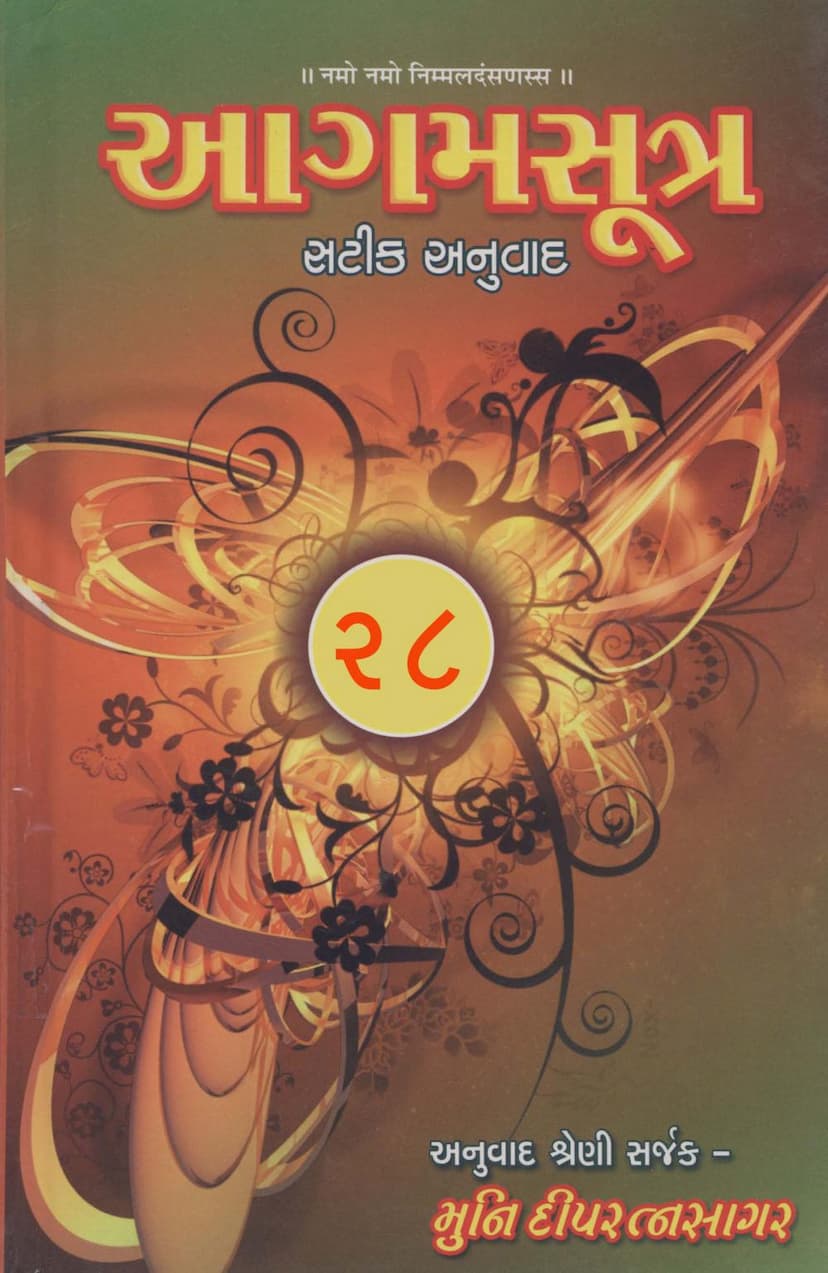Agam 28 Tandulvaicharika Sutra Satik Gujarati Anuvad
Added to library: September 1, 2025

Summary
This document is a Gujarati translation and commentary of the Jain Agam Sutra 28, Tandulvaicharika Sutra. The book is part of a larger series of Agam Sutra translations and commentaries published by Deepratnasagar, with Muni Deeratnsagar being the creator of the translation series.
Here's a breakdown of the content:
- Title: Agam 28 Tandulvaicharika Sutra Satik Gujarati Anuvad (Agam 28 Tandulvaicharika Sutra with Commentary Gujarati Translation)
- Author/Translator: Muni Deeratnsagar (credited as the creator of the translation series)
- Publisher: Deepratnasagar
- Series: This volume is part of a comprehensive series of Agam Sutra translations. Page 2 lists the various Agam Sutras translated, including Anga Sutras, Upanga Sutras, and Panna Sutras.
- Acknowledgments & Sponsorship: Several pages (3-7) are dedicated to acknowledging the donors and supporting organizations (sanghs) who contributed financially to the publication of this series. This highlights the collaborative effort involved in making these sacred texts accessible.
- Content of the Tandulvaicharika Sutra: The core of the document, starting from Page 16, is the translation and commentary of the Tandulvaicharika Sutra itself. The commentary is extensive and detailed, explaining the verses (Sutras) in Gujarati.
Key Themes and Topics Covered in the Tandulvaicharika Sutra as presented in this translation:
- Origin and Classification of Agamas: The commentary begins by discussing the number and origin of Prakeerna Sutras (minor or supplementary scriptures).
- The Nature of Tirthankaras: The text describes the physical and divine attributes (Atishayas) of liberated souls (Jineshwara, Bhagwan Mahavir). It details 28 types of Atishayas, covering aspects like eternal youth, divine aura, pleasant fragrance, and the ability to comprehend all languages.
- Human Biology and Life Cycle: A significant portion of the text delves into the biological aspects of human existence:
- Conception and Gestation: It describes the process of conception, the development of the fetus within the womb, the duration of pregnancy, the number of breaths, and the formation of bodily parts.
- Stages of Life: The Sutra outlines ten stages of human life, from infancy to old age, detailing the physical and mental changes associated with each stage.
- Human Anatomy: An extremely detailed account of the human body is provided, including the number of bones, joints, veins, muscles, and the composition of various bodily fluids and organs (blood, bile, phlegm, marrow, etc.).
- Lifespan Calculations: The text attempts to quantify aspects of life, such as the number of breaths, breaths per day, and the calculation of a human lifespan of 100 years in terms of minutes, hours, days, months, years, and even cosmic time cycles. It also discusses how this lifespan is significantly reduced by factors like sleep, disease, and worldly attachments.
- Dietary Habits: It quantifies the amount of food (rice grains) consumed by humans based on their age and sex.
- The Impermanence and Unattractiveness of the Body: A major philosophical theme is the detailed, often graphic, description of the body's unwholesome and transient nature. It emphasizes that the body is a collection of impure substances, prone to decay, disease, and ultimately death. The commentary aims to foster detachment and aversion towards the physical form.
- The Nature of Women: A substantial part of the commentary is dedicated to a critical and often negative portrayal of women. They are described with numerous negative attributes, likening them to sources of attachment, delusion, sin, and worldly suffering. Their speech, actions, and intentions are depicted as deceitful and detrimental to spiritual progress.
- The Importance of Dharma (Righteousness): Despite the bleak descriptions of the material world and the human body, the text ultimately emphasizes the importance of adhering to Dharma. It states that Dharma is the protector, refuge, and ultimate goal, leading to liberation from the cycle of birth and death.
- The Fallacy of Worldly Attachments: The book argues that worldly possessions, relationships, knowledge, and even lifespan are ultimately fleeting and cannot provide true solace or liberation.
- The Role of Merit (Punya): It highlights that good deeds and adherence to Dharma lead to favorable outcomes, both in this life and in future lives, including attaining divine status or heavenly pleasures.
In essence, Tandulvaicharika Sutra as presented here is a didactic text within Jainism that uses detailed, and at times visceral, descriptions of human biology and the transient nature of the world to promote renunciation, detachment, and the pursuit of spiritual liberation (Moksha) through righteous conduct. The extensive commentary aims to provide a deep understanding of the scriptural meanings and their philosophical implications.